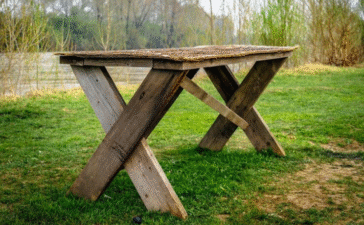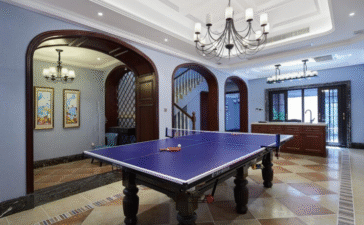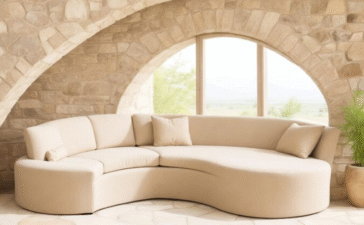Finding the right space for your creative projects is just as important as having the right sewing machine. A dedicated sewing table can turn your crafting experience from a cramped, frustrating task into a smooth, enjoyable process. This guide will walk you through everything you need to know about choosing the perfect sewing station, ensuring your setup supports your passion and improves your workflow. We’ll cover essential features, different types, and even how to build your own, so you can find the best sewing table for your home.
Why a Good Sewing Table is Essential
Anyone who has tried to sew on a dining room table knows the struggle. You are constantly fighting for space, your machine may vibrate excessively, and your posture suffers, leading to back and neck pain. A dedicated sewing table is designed to solve these problems. It provides a stable, purpose-built surface that reduces machine vibration, giving you cleaner, more precise stitches.
Comfort is another major factor. A proper sewing table is set at an ergonomic height, allowing you to work for longer periods without discomfort. Many are designed so your machine sits flush with the tabletop, creating a seamless surface that prevents fabric from snagging or dragging. Functionality is also key; with dedicated storage and ample workspace, you can keep your tools organized and your project running smoothly. A well-chosen table isn’t just a piece of furniture, it’s an investment in your craft, your comfort, and the quality of your work.
What to Look for in a Sewing Table
When you begin your search, you’ll find that sewing tables come in a wide range of styles and configurations. Focusing on a few key features will help you narrow down the options and find a table that truly meets your needs.
Key Features to Consider
The most practical features to look for are storage, adjustability, and durability. A sewing table with storage is a game-changer for keeping your space tidy. Look for models with built-in drawers, shelves, or cubbies to hold your thread, bobbins, scissors, and other accessories. This keeps everything within arm’s reach, saving you time and preventing clutter.
Height adjustability is another crucial feature, especially for those who spend many hours sewing. An ergonomic setup is vital to prevent strain. A sewing table with adjustable height allows you to customize the surface to your ideal working position, whether you prefer to sit or stand. This adaptability ensures you can maintain a healthy posture and work comfortably for longer.
Finally, consider the table’s durability. Sewing machines can be heavy and produce significant vibrations. A sturdy, well-built table made from quality materials will provide a stable foundation, preventing your machine from bouncing or shifting while you work. Look for robust construction, strong leg support, and a solid tabletop that can withstand the rigors of regular use.
Design and Aesthetics
Your sewing table should be functional, but it can also be a beautiful addition to your home. Manufacturers now offer a wide variety of styles to match any decor. If your taste leans towards clean lines and minimalist forms, a modern sewing table design might be the perfect fit. These tables often feature sleek metal frames, simple wood finishes, and innovative, space-saving features that blend seamlessly into a contemporary home.
For those who prefer a more traditional look, classic designs are always in style. A wooden sewing table can bring warmth and timeless elegance to your creative space. These tables often have intricate details, rich finishes, and a sense of heirloom quality. No matter your preference, there is a sewing table out there that will not only enhance your sewing but also complement your home’s aesthetic.
Types of Sewing Tables for Different Needs
The right sewing table for you will depend on your space, your budget, and the types of projects you work on. Let’s explore some of the most common types available.
Sewing Table for Small Spaces
If you’re working with limited square footage, you don’t have to sacrifice having a dedicated sewing area. A sewing table for small spaces is designed to be compact and efficient. Many of these tables are foldable or have drop-leaf extensions. This allows you to create a generous workspace when you need it and then fold it down to a small footprint when you’re done. Some models are cleverly disguised as small cabinets or side tables, making them a discreet addition to a multi-purpose room. These tables prove that you can have a fully functional sewing station even in a cozy apartment or a corner of a guest room.
Sewing Table with Adjustable Height
Ergonomics are incredibly important for any hobby that involves sitting for long periods. A sewing table with adjustable height is an excellent solution for crafters who prioritize comfort. These tables can be manually or electronically adjusted to suit your height, your chair, and your preferred working posture. The ability to switch between sitting and standing can alleviate back pain and improve circulation, allowing you to sew for longer without fatigue. This type of table is a smart investment for your health and can significantly improve your overall sewing experience.
Specialized Sewing Tables
For sewers with specific needs, specialized tables offer features that go beyond the basics. These tables are designed to provide an all-in-one solution for particular aspects of the sewing process.
Sewing Tables with Built-in Cutting Mats
If your projects involve a lot of fabric cutting, a sewing table with a cutting mat can streamline your workflow immensely. These multi-functional tables feature a large, durable surface that often includes a built-in, self-healing cutting mat. This eliminates the need for a separate cutting surface, saving space and making the transition from cutting to sewing seamless. The large, flat top provides ample room to lay out fabric, and the integrated mat ensures you always have a ready-to-use surface for your rotary cutter.
Wooden Sewing Tables
There’s a reason why a wooden sewing table remains a popular choice for so many crafters. Wood offers unparalleled stability and durability. A solid wood table can easily support heavy-duty sewing machines and sergers, minimizing vibrations and providing a rock-solid foundation for precise stitching. Beyond their practical benefits, wooden tables have a timeless aesthetic appeal. They bring a sense of warmth, tradition, and craftsmanship to a sewing room, creating an inspiring environment for your creative pursuits. A well-made wooden sewing table is a long-lasting investment that can be passed down through generations.
DIY Sewing Tables: Create Your Own
If you can’t find a commercial table that fits your exact needs or budget, or if you simply enjoy a hands-on project, building a DIY sewing table is a fantastic option. Creating your own table allows you to customize every aspect, from the dimensions and height to the storage solutions and finish.
To get started, you’ll need a clear plan. Measure your space and your sewing machine, paying special attention to the height needed for an ergonomic setup. Common materials include plywood for the top, sturdy lumber for the legs, and pre-made cabinets or cube storage units for the base. Tools you might need include a saw, a drill, a measuring tape, and wood screws. There are countless plans and tutorials available online that can guide you through the process, from simple designs using two storage units and a countertop to more complex builds with custom features. A DIY table is a rewarding project that results in a one-of-a-kind workspace tailored perfectly to you.
Reviews: Top-Rated Sewing Tables You Should Consider
Navigating the market can be overwhelming, so we’ve looked at sewing table reviews to highlight a few top-rated options that consistently receive praise from users.
One of the best sewing tables for home use is the Arrow Gidget II. This portable table is beloved for its sturdy steel frame and adjustable platform that allows your machine to sit flush with the surface. It’s lightweight and foldable, making it ideal for small spaces or for taking to classes.
For those needing more storage, the Sauder Craft Pro Series cart is a popular choice. It features a large work surface, multiple drawers for storage, and durable casters for mobility. Its clean, modern design fits well in most homes.
If you’re looking for a larger, more permanent station, the Kangaroo and Joey cabinet is a top contender. This setup includes a spacious three-position sewing cabinet and a rolling caddy with three drawers for storage. It offers a huge amount of workspace and is built to last, making it a favorite among quilters and serious sewists.
You would also like: “furniture table dining“
Find the Perfect Sewing Table for Your Needs
Choosing the right sewing table can significantly impact your crafting experience. By considering your available space, sewing habits, and desired features, you can find a table that accommodates your machine and inspires creativity. Whether you choose a compact, foldable design, a versatile table with adjustable height, a classic wooden piece, or a DIY creation, the perfect sewing table is available. It will provide the stable, comfortable, and organized workspace you need to complete your sewing projects with joy and ease.
Frequently Asked Questions
What is the best height for a sewing table?
The ideal height for a sewing table depends on your body height and whether you prefer to sit or stand. For a seated position, the table should be low enough that your elbows are at a 90-degree angle when your hands are on the machine. This is often around 28-30 inches. An adjustable height table is the best option to achieve perfect ergonomic alignment.
Can I use a regular desk as a sewing table?
While you can use a regular desk, it’s not ideal. Desks are typically higher than sewing tables, which can cause shoulder and neck strain. They also may not be sturdy enough to handle the vibrations of a sewing machine, leading to skipped stitches. A dedicated sewing table is designed for stability and ergonomic comfort.
How do I choose a sewing table for quilting?
Quilters need a large, flat surface to support the weight and bulk of a quilt. Look for tables with large extensions or drop leaves. A table that allows your machine to sit flush with the surface is also essential to prevent the quilt from dragging. The Kangaroo and Joey cabinet is a great example of a table designed with quilters in mind.
What is a sewing cabinet?
A sewing cabinet is a piece of furniture that encloses the sewing machine when not in use. They often feature a lift mechanism to raise and lower the machine, ample storage, and expandable work surfaces. They are an excellent choice for keeping a sewing room tidy and protecting the machine from dust.
How much should I expect to spend on a good sewing table?
Prices for sewing tables vary widely. Small, simple tables can start around $100-$200. Mid-range tables with more features and storage typically fall between $300 and $600. High-end sewing cabinets with extensive workspace and premium features can cost $1,000 or more. A DIY sewing table can be a more budget-friendly option.












